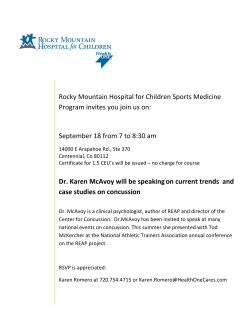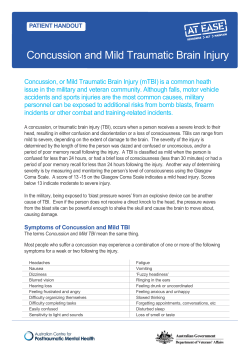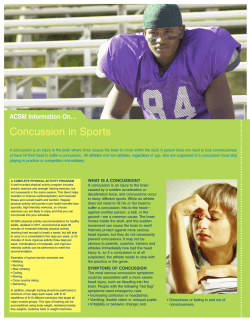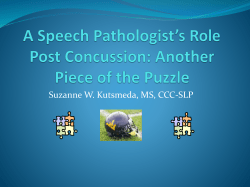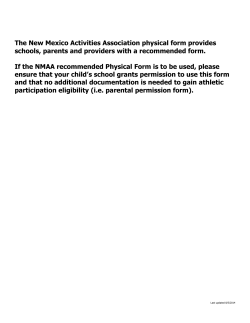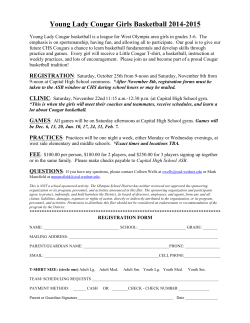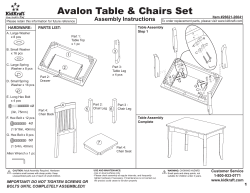
Diagnostic and Management Challenges When Concussion Becomes Post-Concussion Syndrome
Diagnostic and Management Challenges When Concussion Becomes Post-Concussion Syndrome John Leddy MD FACSM FACP Medical Director, University at Buffalo Concussion Management Clinic Concussion.buffalo.edu Goals and Objectives • To present an evidence-based approach to PCS that focuses on the identification of specific postconcussion disorders (PCDs). • To give providers a logical treatment approach to PCDs based upon features of the clinical history, physical examination, and response to exertion. What is concussion? (McCrory P Clin J Sport Med. 2013) Zurich 2012- Concussion is a brain injury defined as a Complex pathophysiological process induced by biomechanical forces. This is not really defined. In some cases symptoms may be prolonged. When does Concussion become PCS? • DSM IV: cognitive deficits in attention or memory and ≥ 3 symptoms for > 3 months. • World Health Organization : three or more of: – headache, dizziness, fatigue, irritability, insomnia, concentration difficulty, or memory difficulty. – No specific timeframe When does Sport-Related Concussion (SRC) become PCS? • Zurich 2012: Persistent symptoms (>10 days) in 10–15% of concussions. – In general, symptoms are not specific to concussion and it is important to consider other pathologies. • Athletes: symptoms > weeks-months (Harmon. AMSSM Position Statement. CJSM 2013) • Youth (13-16 yrs.): >4 weeks (Zuckerman et al. Surg Neurol Int. 2012) – In SRC, 90% athletes recover 4 wks. – 13-16 years old take longer to return to neurocognitive and symptom baselines than athletes18-22 years old. Predictors of PCS • Headache Apslund et al 2004 • Amnesia Apslund et al 2004 • Memory Lovell et al 2003 • Processing speed Lau et al 2011 • History of concussions Guskiewicz et al 2003 • Age Field et al 2003; Sim et al; 2008 Pellman et al 2006 • Gender Barnes et al 1998 Summary of Research on Prognostic Factors • Different studies find different predictors of developing PCS • However, combined, the predictors do not explain much of the variance • A big problem with research on prognostic factors is the lack of agreement of what constitutes “PCS” • “PCS” is not a single syndrome. The pathophysiology of SRC is much better understood than that of PCS To diagnose SRC, best to have a test. Stress precipitates symptoms – Zurich 2012: Clinical diagnosis based on recognition of injury, symptoms, cognitive and cranial nerve function, and balance. – cNP testing: not validated as a diagnostic tool but can show cognitive deficits longer than athletes are symptomatic. (Harmon. AMSSM Position Statement. CJSM 2013) – SCAT 3 (symptoms, SAC, BESS) • current standard but needs validation. • sens., spec. and predictive value unknown (same for SCAT-2). (Harmon. AMSSM Position Statement. CJSM 2013) To diagnose recovery from SRC. Best to have a test • Zurich 2012: Graduated RTP Protocol – • Patients may RTP once asymptomatic at rest and with provocative exercise. Nobody is “Asymptomatic” (Lovell et al. Appl Neuropsychol 2006). – • Better to say “recovered to a baseline (or normative) level of symptoms” Choose your stress test – SCAT 3? (needs validation) – cNP testing? (questionable reliability) (Randolph et al J Athl Train 2005) – Current standard is the Zurich RTP Protocol (but not validated…) Until now…Systematic evaluation of provocative exercise to determine concussion recovery Buffalo Concussion Treadmill Test (BCTT) • Modified Balke Protocol – Speed = 3.6 mph constant. – Increase grade1%/min. – Submaximal symptom-limited threshold = not recovered. • – Threshold is represented by the HR at symptom exacerbation Maximum exertion without symptom limit = recovered. What about Return to School? (Darling et al CJSM 2014) On telephone f/u, 38% athletes reported symptoms upon return to the classroom. Interestingly, cNP test results were not predictive of either return to school difficulties or RTP. We believe return to school issues need more attention from clinicians and more formal study. Post Concussion Syndrome. To diagnose, best to have a test • Cannot use Symptoms N=128 (Leddy et al. in press) • PCS (n=36) – • Headache, Dizziness, Foggy, Off balance Cervical/vestibular injury (n=92) – Headache, Dizziness, Foggy, Off balance To diagnose PCS, best to have a test. – NP testing? – Meta-analysis: most cognitive deficits resolve after 7 days in SRC. (Belanger et al J Int Neuropsychol Soc 2005) – NP testing cannot reliably distinguish between concussion and orthopedic injury. (Boake et al. J Neuropsychiatry Clin Neurosci 2005) Advanced Imaging (fMRI, DTI)? Recovered? Looks like it is on fMRI (Leddy et al 2013) Recovered? Looks like it ain’t on DTI (Polak P et al. in press) To treat PCS, need a diagnosis. • Do prolonged symptoms reflect a prolonged version of the concussion pathophysiology or a secondary process? (Kutcher JS. Sports Health 2010) • Do prolonged symptoms reflect a prolonged version of the concussion pathophysiology or a different process? (Leddy et al. Sports Health 2012) How to define PCS more systematically? • Physical examination focus should be on physiology/autonomic nervous system – • e.g., cranial nerves, orthostatic vital signs. Response to exertion (Leddy et al 2010, 2013) – Symptom-limited submaximal threshold = persistently abnormal concussion physiology (dysautonomia of cerebral blood flow). – Exercise to exhaustion without a threshold = alternative diagnosis. • Focus on cervical and vestibular/ocular examinations What if PCS was actually multiple PCD’s? Common Treatments For PCS (Leddy et al. Sports Health 2012) • (Radical) Rest • Information, counseling – • Anti-Depressants – • Some evidence of efficacy Little evidence of efficacy Compensatory strategies – Particularly for students returning to class. – Needs further study. How do we treat Physiologic Post Concussion Disorder? A proactive approach to treating Physiologic PCD • Establish the diagnosis by a symptom-limited threshold on the treadmill (or other exercise modality, e.g., bike). • Exercise prescription – 80-90% of achieved HR = target HR. • HR monitor is KEY to prevent athlete from over-exertion. – 20 min/day at target HR (bike first, then running) – 6-7 d/wk. – Increase target HR 5-10 bpm q1-2 weeks A proactive approach to treating Physiologic PCD • ≥ 85% age-predicted max HR x 20 min without symptoms =“Physiologic Recovery” • Advice on RTP based on history (e.g. number of prior concussions) and other signs and symptoms. Exercise Treatment Outcome in P-PCD • 12/12 subjects returned to full sport or work (Leddy et al CJSM 2010) • 4/4 exercise treated subjects had symptom resolution v. stretching placebo control (Leddy et al. Jl Head Trauma Rehabil 2013) • 77% of P-PCD (n=65) treated with aerobic exercise returned to full sport or work (Baker et al. Rehabilitation Research and Practice. 2012) – *5 of 6 who refused to exercise did not return to full function How do we diagnose Cervicogenic/Vestibular/Ocular PCD? • Exercise to exhaustion without a threshold on the treadmill. • Abnormalities on physical exam – Signs and symptoms during visual tracking maneuvers. – Cervical tenderness, spasm, reduced proprioception. – Altered balance. Abnormal Accommodation Normal is 6 cm or less • Eye push-ups – Scheiman et al. Optom Vis Sci 2011 – Borsting et al. Optom Vis Sci 2012 – * has not been evaluated in concussion • Goal is to move the pencil to within 2 to 3 cm of the brow, just above the nose on each push up while trying to keep the target single and clear. • Perform the pencil push-ups procedure 15 min per day, 5 d per week. Vestibular Ocular Reflex and Dynamic Visual Acuity Heitger MH et al. Brain: a journal of neurology, 2009 Cervical Relocation Test Proprioception (trainable!) (Armstrong B et al. Sports Med 2008) Tandem Gait Balance Test (Schneiders AG et al. Journal of science and medicine in sport/Sports Medicine Australia, 2010) A proactive approach to treating Cervicogenic/Vestibular/Ocular PCD • Cervical and vestibular/ocular rehabilitation. • Aerobic exercise (can’t hurt!). • Outcome (Baker JG et al. Rehabilitation research and practice. 2012) – 64% returned to full function – Subgroup that doesn’t respond fully • Why? Prolonged symptoms (>6 months) before evaluation… Cervical and Vestibular Rehabilitation • An RCT and a case series reported benefit of a combined approach of orthopaedic and vestibular PT following concussion (Schneider K et al. CJSM 2009 and 2012) • If persistent headache after concussion suggests a cervicogenic etiology, cervical spine manual therapy is effective (Jull G et al. Spine 2002) Combined PCDs • Response to exertion – • Physical Exam – • Symptom threshold + autonomic, cervical and/or vestibular and/or ocular findings Management Options – cervical and vestibular/ocular rehabilitation plus – Sub-symptom threshold aerobic exercise Migraine PCD • Pathophysiology (similar to concussion) – failure of brain ion homeostasis, efflux of excitatory amino acids, increased energy metabolism, changes in cerebral blood flow. • Symptoms: classic or common migraine. • Treadmill Test: no symptom threshold. • Management Options: Triptans, prophylactic medications. Affective PCD Depression, Anxiety, PTSD… Diagnoses of Exclusion in PCS Medications in SRC • • Not much evidence of efficacy – NSAIDs – methylphenidate, anticonvulsants, antidepressants Amantadine (Reddy et al. J Head Trauma Rehabil 2012) – may alleviate symptoms and promote neurocognitive recovery in some athletes. – Retrospective study and although greater improvement in medication group, control group and all patients demonstrated improvement over time. – Use limited by side effects. How much rest is enough? Early rest has theoretical basis (Schneider KJ et al BJSM 2013) • Metabolic crisis of high energy demand • Vulnerable period to second injury • Premature exercise in rats hinders recovery Or too much? No evidence that >3 days rest is beneficial in adult concussion. (Silverberg and Iverson, J Head Trauma Rehabill 2012) Sleep disturbance in PCS Common problem • 96 UB clinic patients with months-years symptoms. • Most common symptom is fatigue. • 58% had Physiologic PCD. Remainder: other PCDs. • Insomnia Severity Index (ISI): patient report. • Results • 57%: mild to severe sleep disturbance (v. 25% general public). • 64% for those with P-PCD; 48% other PCDs (ns). • Athletes less likely to report severe sleep disturbance, regardless of diagnosis. • Patients with longer duration of symptoms had worse sleep. Treating Sleep in PCDs • Hypnotics not generally effective in alleviating sleep disturbances long term. • • Zolpidem, eszopiclone, etc. Others (may have side effects) • Amitryptiline • Trazodone Consider sleep study if no response • Soldiers with blunt trauma mTBI had significant rate of OSA (Collen J. et al. Chest 2012 ). Treating Sleep in PCDs • No evidence to support stimulant- or sleep-promoting medications in the acute setting. • Potential causative factors such as pain, anxiety, or depression need to be assessed and treated. • PCDs (some evidence in moderate-severe TBI for the following)(Ponsford J et al Jl Head Trauma Rehabil 2012) • Sleep hygiene • Modafinil (reduces daytime sleepiness) • Melatonin* (I use a lot in adolescents) • TBI may have lower melatonin production in the evening, which is associated with less REM sleep. • 5 mg Melatonin: moderate effect on daytime alertness. Lastly, PCS Issues Complex problem, no single solution • Need RCTs of all forms of treatment in PCDs. • Helps to narrow the differential diagnosis of prolonged symptoms using a physiologic approach… • but our experience may not be yours because of the patient population at a University Sports Medicine/Concussion clinic. • Have we resolved RTP protocols for all athletes? • • pro v. college v. adolescent v. children Others…. Take Home • PCS is not one syndrome but a group of disorders having similar symptoms. • Focus on the examination of visual tracking and accommodation, cervical abnormalities (e.g. proprioception), and balance. • Let physical examination findings and, if available, response to exertion guide your Rx • • Aerobic exercise, ocular and vestibular rehab, cervical rehab… PCS is not primarily a psychological disorder. • Mood disorders are diagnoses of exclusion References 1. Leddy JJ, Sandhu H, Baker JG, Sodhi V, and Willer B. Rehabilitation of Concussion and Post Concussion Syndrome. Sports Health 4:147-154, 2012. 2. Baker JG, Freitas MS, Leddy JJ, Kozlowski KF, and Willer B. Return to full functioning after graded exercise assessment and progressive exercise treatment of postconcussive syndrome. Rehabilitation Research and Practice 2012; 705309. 3. Leddy JJ, Cox JL, Baker JG, Wack DS, Pendergast DR, Zivadinov R, and Willer B. Exercise Treatment for Post Concussion Syndrome: A Pilot Study of Changes in fMRI Activation, Physiology and Symptoms. J Head Trauma Rehabil. 28:241-249, 2013. 4. Darling SR, Leddy JJ, Baker JG, Williams AJ, Surace A, Miecznikowski JC, and Willer B. Evaluation of the Zurich Guidelines and Exercise Testing for Return to Play in Adolescents Following Concussion. Clin J Sport Med. 2013 Oct 31. [Epub ahead of print] 5. Leddy JJ and Willer B. Use of Graded Exercise Testing in Concussion and Return-to-Activity Management. Current Sports Medicine Reports 12(6):370-376, 2013. 6. Ellis M, Leddy JJ and Willer B. Evaluation and Treatment of Physiologic, Vestibulo-ocular, and Cervicogenic Post-Concussion Disorders. Brain Injury (in press). Mother’s Testimonial “There is something intangible, science notwithstanding, in returning agency to a driven but injured athlete through the workouts.” ...”intuitively better than sitting and waiting for one treatment or pill to work, or not.” …”the implicit message that recovery is not about fancy scans and technology but is a relatable athletic grind, spoke to my daughter immediately.”
© Copyright 2025
